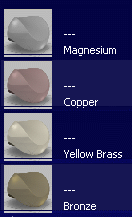Click Materials Palette
 . .
The Materials palette appears. The materials palette comprises three components:
- Filter Specification Tree that allows you to filter materials. (Left zone)
- Edit Applied Material Balloon command that allows you to access a dedicated balloon toolbar to edit applied materials. The balloon toolbar appears when you click Edit Applied Material Balloon and select geometry from either the model geometry or the
specification tree.
- Palette View that displays the materials (right zone). In Details View
 any material attribute added as a filter appears in a column. See Filtering Materials in the Palette for more information. any material attribute added as a filter appears in a column. See Filtering Materials in the Palette for more information.

If the material name is not entirely displayed, you can display it by moving the cursor over the material: a tooltip appears giving you the full material name.
Optional: Modify the display mode of the palette content. - To display the palette content with thumbnails, click Thumbnail View
 . .
- To display the palette content in tiled view, click Tiles View
 . .
- To display the palette content in detailed view, click Details View
 . .
- Thumbnail view

- Tiles view
 - Details view

To undock the palette, click  . . You can move and resize the palette. To dock the palette, click  . . You can resize the palette, but you cannot move it. To modify the content of the Materials palette, use the Search box of the Bar. The content of the palette is replaced by the result of your search criteria. To restore the full content of the palette, click Materials Palette
 . . To apply a material to a support: - Click a material in the Palette view
The cursor changes to indicate that you are in the material application mode.
- Select a geometry, a 3D shape, or a product from either the model geometry or the
specification tree.
The Material balloon toolbar appears. For more information about the Material balloon toolbar, see About the Material Balloon Toolbar.

- To change a support, click Apply Up
 to apply the material to the upper object in the selection path or click Apply Down to apply the material to the upper object in the selection path or click Apply Down  to apply the material to the lower object in the selection path. For more information about the selection path, see About the Material Balloon Toolbar. to apply the material to the lower object in the selection path. For more information about the selection path, see About the Material Balloon Toolbar.
- To apply a material to another support, repeat Step b.
- To change a material, click another material in the Materials palette.
- To remove the last material you applied to a support, click Undo
 . . The material is automatically removed from the last support selected for application.
- To close the balloon toolbar, click
 . .
To edit an applied material: - Click Edit Applied Material Balloon.
The cursor changes to indicate the material edit mode is active . For more information, see About the Edit Applied Material Balloon Toolbar. . For more information, see About the Edit Applied Material Balloon Toolbar.
- Select a geometry from either the model geometry or the
specification tree.
The name of the applied material appears in a tooltip as you pass your cursor over the material's type icon.
- Click Delete
 to remove the applied material. to remove the applied material.
- Click Undo
 to reverse the delete operation. to reverse the delete operation. The material is automatically reapplied to the last selected support.
- Click Reapply to apply the selected applied material to other supports.
The Materials balloon toolbar appears and replaces the Edit Applied Material balloon toolbar. The cursor changes to indicate the material application mode is active  . .
- To edit an applied material, repeat step a.
- Click Close
 . .
When you are done applying and editing materials, click  to close the Materials palette. to close the Materials palette.
|